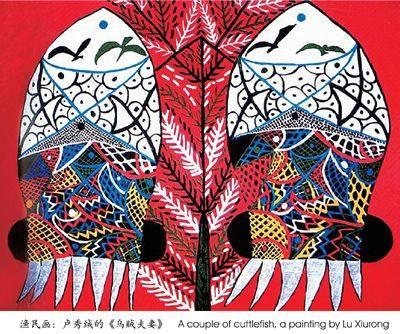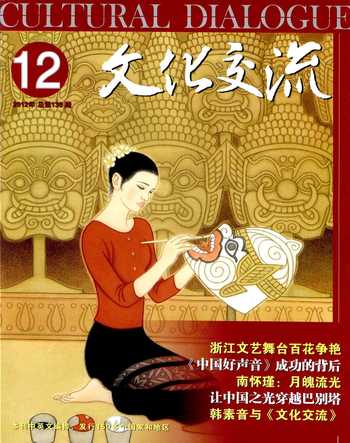嵊泗列岛的文化名片
金瑛



浩瀚东海上的浙江嵊泗列岛,是一片壮丽而神奇的蓝色土地。说壮丽,是因为她有山海奇观的自然景色;说神奇,是因为她有丰富厚重的文化底蕴。如今,嵊泗县把渔民画、海洋风光摄影、渔歌这三张文化名片递上。
浸蘸海水的挥洒—嵊泗渔民画
嵊泗渔民画真率、浑朴、自然。在一幅幅极具想象力的画作里,流淌着嵊泗列岛先民的苦难、勇敢和不屈的意志,呈现出渔家儿女对理想、对生活的美好追求和强烈渴望。
嵊泗的民间绘画素有传统。过去,渔民往往请画师借新船下水或新房落成,在船体上、墙体上描绘大海:独特的海岛地理、奇异的岩礁传说、丰富的海洋生物、多彩的鱼类故事、别样的渔家风俗……成为一道原生态的艺术风景线。
为了继承并发扬光大这一民间传统,1986年9月,嵊泗县文化馆以美术干部李佛裔、李飞雪为辅导老师,举办了一次实验性的渔民画培训班,学员多是乡镇文化站的管理人员和文娱活动积极分子。通过短短三个月的培训,他们这些从来没有拿过画笔的年轻人,怀揣着祖辈浸润着海水的梦想,在渔船、房屋上,更在画纸、画板、宣传栏上,通过有趣的构思、夸张的笔法,展现着大海神秘而奇特的魅力,表达着自己对之的热爱。
嵊泗渔民画于1987年10月在上海美术馆展出,同年12月又在中国美术馆破例展出,部分作品被两馆收藏。这宣告嵊泗渔民画已成为中国现代民间绘画中独树一帜的一个画种。美术评论家何振志,画家朱膺、陈创洛等给予了高度评价。画家沈柔坚说:这是中国现代美术的一种新的、大胆的突破。国内各大报纸纷纷对之进行报道,港澳版《中国旅游》、台湾《雄狮美术》等也相继刊出介绍文章并选登作品。1988年2月9日,文化部命名嵊泗县为“中国现代民间绘画画乡”。
一时间,嵊泗渔民画走出了小岛,走向了世界,远赴日本、法国、德国等国展出,有300余件作品被海外画商和艺术家购买收藏。
多年来,嵊泗渔民画中产生代表性影响的作品有卢秀绒的《乌贼夫妻》等。吴章夫打过船、做过渔船老大,他把曾经的生活与生产场景撷取到自己的作品中,内容大胆肯定,色彩丰富艳丽。龚忆梦是嵊泗渔民画第二代辅导者,在辅导与创作中带领新一代作者深入挖掘创作元素,承前启后。
自2006年起,随着五龙乡田岙“东海渔村”旅游项目的动工兴建,嵊泗渔民画再一次被大规模地搬上渔家墙头。具有强烈视觉冲击力的渔民画,让游客在体验海岛自然景色、民俗风情的同时,又置身于民间艺术的海洋之中,充分享受美感。如今,田岙又有中国美术学院·嵊泗东海渔村墙体壁画创作基地和舟山渔民画创作基地的落户。“东海渔村”借助渔民画来促动渔家乐旅游的持续向前发展。
守望海岛的印记—嵊泗风光摄影
嵊泗列岛有404座岛屿,它们峰峭异,洞幽邃,滩平远,而且人文景观丰富,渔岛风景浓郁,有鉴真东渡扶桑时滞留过大悲山,有明代将领侯继高书写的“山海奇观”摩崖石刻,有国家重点文物保护单位、远东第一大灯塔花鸟灯塔,更有嵊山渔港里如林的桅樯、遮天的船旗和入夜后的万船火海。这些无不飘逸着浓浓的海洋文化的气息,讲述着生动感人的渔岛故事。
嵊泗摄影家创作了无数嵊泗风光作品。这些包含着自然与人文美景的风光作品,用厚重的内涵给人以感官和心灵的愉悦,使人在审美中领略到深刻的来自海洋的讯息,平添无尽情趣。
30多年来,嵊泗的风光摄影作品已有上千幅见诸报刊,近200幅作品获国际国内大奖。其中,《龙舟赛后意阑珊》获日本第49届国际摄影沙龙展金牌奖,《97·11号台风袭击浙江沿海》和《船工号子》入选全国第8届“群星奖”和第12届“群星奖”铜奖,《母亲》获首届世界华人摄影艺术大赛铜奖,《渔家乐》在中国第10届国际摄影艺术展中获国际摄影艺术联合会银牌奖,《倾覆》在中国第11届国际摄影艺术展中获国际摄影艺术联合会铜牌奖,作品《冲击浪血礁》获中国2011上海国际“郎静山摄影艺术奖”金像奖。土生土长的嵊泗摄影家刘昌明,20世纪70年代末开始自学摄影。多年来,他以海岛自然风光、渔民生产、渔家民俗和海岛发展为题材进行创作,形成了自己独特的艺术风格,得到中国摄影界的关注和认可。他把嵊泗风光摄入镜头,向世人展示,先后在北京、上海、杭州等地举办个人摄影作品展,并出版风光作品集。2005年,他在北京中国美术馆举办“美丽的嵊泗列岛——刘昌明摄影艺术作品展”,老一辈摄影艺术家徐肖冰、侯波等出席了开幕式。人民日报、新华社、北京电视台、东方卫视等30余家媒体对他的摄影展作了报道。展览之后,他的《大海巨澜》《撒在沙滩上的不是梦》等7幅作品被中国美术馆收藏,开创了在该馆个人摄影作品收藏之最。2006年,文化部文化促进会、国家邮政局联合发行了以他的作品介绍嵊泗风光的专题邮票,被国家博物馆、国家邮政博物馆、联合国儿童基金会和日本、德国等十多个国家驻华使馆收藏。
为全面打造“美丽海岛”,充分展现家乡的美丽景色,如陈根信、包仁泉、贝飞存等嵊泗本土摄影家不断涌现,更多的嵊泗风光摄影作品被推向全国,走向世界。
协和海浪的讴歌—嵊泗渔歌
嵊泗渔歌乃渔民所歌,渔家所歌,是渔民们自发创造的一种音乐文化。在中国漫长的海岸线上,很多地方有渔歌流传。在这些千姿百态、丰富多彩的渔歌当中,嵊泗渔歌以她喷薄而出的生命力自成一格,仿佛发自灵魂的呐喊,振聋发聩、动人心魄!
嵊泗列岛的广阔海天是生产渔歌的母体,特殊的自然环境、生产作业方式和渔民个性,使渔歌的唱腔和旋律充满原始的野性、粗犷和细腻的融合以及生命的张力。尤其是渔民号子,那或雄壮高昂、或慷慨低回的旋律,淋漓尽致地表达了渔家汉子自由奔放、顽强奋斗的豪情。这种豪情,是穿越千年历史、积淀深厚人类情感的渔家史诗,是渔乡文化的艺术珍宝。
2005年以来,嵊泗县文广局花大力气进行嵊泗渔歌的挖掘、研究与创作,并取得了可喜成绩,有十多首新渔歌获省级、国家级大奖。
为使嵊泗渔歌能够唱出渔舍唱出船舱,嵊泗本土音乐家舒信虎早在上世纪80年代,就作为一名乡镇文化站干部,参加了浙江省民间文化三集成的搜集整理工作。那次搜集,大大丰富了他的知识储备和生活阅历,为他以后对嵊泗渔歌的研究和传承打下了良好的基础,积累了宝贵的文史资料,如他早期创作的歌曲《捕鱼汉子》《船魂》《捡螺歌》等,无一不是赞美家乡海岛的美丽,无一不是反映海岛人民勇敢豪爽、纯朴厚道的精神,无一不是歌颂海岛新渔村欣欣向荣的景象。
2005年后,舒信虎潜心于渔歌文化的挖掘与研究,撰写了很多具有较高学术价值的研究文章。2007年,他根据自己多年研究心得和创作实践,撰写了近3万字的学术文章《嵊泗渔歌赏析》,对1000多年来散落在民间、面临消失的嵊泗渔歌,第一次从理论层面,对它们的形成、特点、社会功能、文化价值等方面进行详尽的论述,为嵊泗渔文化、为嵊泗人民留下了一笔宝贵的音乐文化财富。
想把嵊泗渔歌打造成一种品牌来加以保护和传承,除了理论研究以外,更重要的还是要生产出优秀的艺术作品来。嵊泗县文广局倾力支持打造的小组唱《东西南北风》获浙江省音乐新作大赛创作金奖、浙江省群星奖、中国西奥夫渔歌邀请赛一等奖;对唱《哥是舢板妹是缆》获浙江省首届组唱类歌曲大赛创作银奖、首届江浙民歌大赛创作金奖;小组唱《摇橹谣》获首届中国农民文艺汇演银穗奖;表演唱《带鱼煮冬菜》获浙江省第七届音乐新作大赛创作金奖、长三角江南风歌曲新作大赛创作金奖;表演唱《我的阿姐囡》获浙江省第八届音乐新作大赛创作金奖;小组唱《阿拉舟山人》获中国海洋歌曲征集评选三等奖等。短短几年,嵊泗渔歌声名鹊起,很多媒体、音乐院校慕名前来采访、采风。与此同时,嵊泗渔歌受邀请演出也越来越多,先后参加了上海国际艺术节、长三角地区非物质文化遗产优秀项目展演、浙江省乡镇优秀文艺节目展演、江浙沪优秀文艺节目展演等。尤其值得一提的是,《东西南北风》和《哥是舢板妹是缆》两首渔歌两次上北京、进央视,参加北京奥运会系列文化活动的展演,让更多的人知道了舟山渔歌,得到众多专家的认可和看好,受到广大中外观众的好评。用嵊泗渔歌作为主线而创作的大型海乡风情歌舞剧《东海谣》更是飞向远方。
2009年,嵊泗渔歌被列入浙江省非物质文化遗产保护名录。
今天,嵊泗这三张文化名片正融入现代意识,以崭新的面貌出现在世人面前,成为嵊泗对接世界的形象窗口。
(本文照片由作者提供)
Cultural Hallmarks of Shengsi Islands
By Jin Ying
Shengsi Islands, part of Zhoushan Archipelago in East China Sea, are culturally reputed for fishermens painting, scenic photography and fishermens singing.
Fishermens Paintings
Noted for straightforwardness, simplicity and naturalness, the genre reflects the suffering and the unyielding spirit of the past and portrays the longing for a beautiful life of today. Artistic painting goes back to ancient times in Shengsi Islands. In the past, local residents painted beautiful images on fishing ships and external walls of their houses.
The tradition was picked up in September 1986 when the Cultural Center of Shengsi County decided to hold an experimental training course. The participants were cultural workers at township cultural centers and enthusiasts. After three months intensive training, the young amateurs, without any prior experience of painting seriously, were able to create paintings that were so unusual.
Promoted as Shengsi Fishermens Paintings, their works were exhibited at Shanghai Art Museum in October 1987. China Art Gallery made an exception to hold a special exhibition for these young island artists. The exhibition events established Shengsi Fishermens Painting as a sub-genre in modern Chinese folk painting. The best of the exhibits went into the collections of the two art institutions. Critics thought highly of the amateurs bold and imaginative creativity, thinking the art from Shengsi Islands made a breakthrough in the field of modern Chinese art. Media on the Mainland, Taiwan and Hong Kong covered the two exhibitions extensively and praised the paintings from Shengsi Islands. On February 9, 1988, the Ministry of Culture named Shengsi County as home of Chinese Modern Folk Painting.
Shortly afterwards, the Shengsi Island artists exhibited their works in Japan, France and Germany. More than 300 were bought by collectors and galleries.
Nature Photography
Composed of 404 isles scattered across East China Sea, Shengsi offers a breathtaking array of cliffs, caves, and beaches. Moreover, it boasts a few places of historical and cultural interests such as Great Sorrow Hill where Monk Jianzhen was stranded on his eventful journey to Japan in the Tang Dynasty (618-907), an inscription of four characters by General Hou Jigao carved on a cliff in the Ming Dynasty (1368-1644), and the largest lighthouse in the Far East. On top of all these scenic spots is Shengshan Fishing Port: a forest of masts and ship banners as well as a sea of lights at night. The islands provide opportunities for photographers. Over the past 30 some years, more than 1,000 photographs of the islands have appeared in the news media and professional publications and nearly 200 have won prestigious photography prizes at national and international level.
Liu Changming, a photographer who was born and brought up in Shengsi, began to study photography in the 1970s. Over years, he has created series of photographs of landscape, fishing, folk customs, and development across the islands. He is widely recognized for his distinct style and subjects. In 2005, he held a solo photo exhibition in China Art Gallery, which was a huge success. The unusual viewpoints received rave reviews in the mainstream media. Seven of the exhibits went into the collection of the gallery and no other photographer had ever been honored this way. In 2006, China Postal Service and Cultural Promotion Association under the Ministry of Culture jointly issued a set of stamps featuring the natural beauty of Shengsi as he photographed. Liu Changming is not the only local photographer that has caught the attention of the outside world. Chen Genxin, Bao Renquan and Bei Feichun are excellent representatives of a new generation of local photographers.
Fishermens Work Songs
As fishing was the economic mainstay of Shengsi Islands for millennia, local residents have sung work songs on ships and at fishing ports. In 2005, the cultural authorities of Shengsi County took serious measures to look into the treasure of local fishermens work songs and create new songs.
The collection work started in the 1980s. Shu Xinfu, a Shengsi native and musician working at a cultural center in a rural town, took part in a provincial project for collecting works of folk arts and crafts. That experience enriched his career and opened his eyes to local fishermens work songs.
Since 2005, Su Xinhu has dug deep into work songs and done theoretical work on the value and appreciation of these folk songs. In 2007, he authored a 30,000-character essay on the fishermens work songs of Shengsi, the 1,000-years-old folk musical tradition that is on the verge of vanishing.
To preserve the tradition and carry it to the future, the local cultural authorities have encouraged musicians to write new-generation fishermens work songs. These songs are no longer confined to the content of fishing and fishing-related work. These new songs are created to reflect a wider range of life on the sea and the islands since the late 1970s when the reform and opening up to the outside world started. Over the last few years, the musical creativity in Shengsi has reaped many awards at competitions at provincial and national level.

